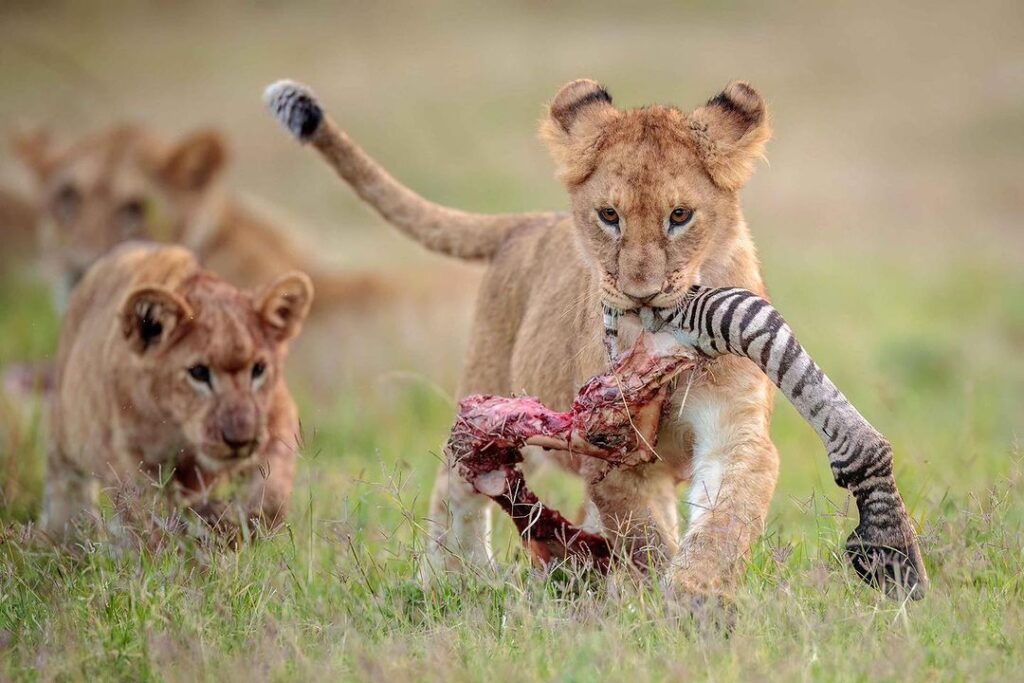Nestled in the heart of Tanzania, the Serengeti National Park stands as a testament to the unparalleled wonders of African wildlife and landscapes. This iconic park is renowned worldwide for its epic annual Great Migration, where millions of wildebeest, zebras, and other animals embark on a dramatic journey across the plains in search of greener pastures.
Serengeti National Park Is the second largest area protected area in Tanzania which covers 14763km 2 after Selous Game Reserve. Extraordinary Wildlife Encounters Serengeti National Park boasts an impressive array of wildlife, supporting a rich and thriving ecosystem. It is home to the famous African Big Five – lions, elephants, buffalos, leopards, and rhinoceros. Apart from these majestic creatures, visitors can observe an abundance of other wildlife including cheetahs, giraffes, zebras, wildebeests, hyenas, and hippos. The park is also a haven for bird lovers, with over 500 bird species gracing the skies and trees.
The Heart of Great Wildebeest Migration In Tanzania
The Great Wildebeest Migration Phenomenon is One of the most awe-inspiring natural events on the planet, the Great Migration, takes place within the boundaries of Serengeti National Park. Witness millions of wildebeests, zebras, and gazelles as they embark on a perilous journey across the park, driven by instinct and the pursuit of greener pastures. Follow their path as they cross treacherous rivers and brave encounters with predators, making for an unforgettable spectacle against the backdrop of the Serengeti’s vast landscapes. The Serengeti offers arguably the most scintillating game-viewing in Africa: great herds of buffalo, smaller groups of elephant and giraffe, and thousands upon thousands of eland, topi, kongoni, impala, and Grant’s gazelle.
A million wildebeest each one driven by the same ancient rhythm, fulfilling its instinctive role in the inescapable cycle of life. A frenzied three-week bout of territorial conquests and mating; survival of the fittest as 40km (25 miles) long columns plunge through crocodile-infested waters on the annual exodus north; replenishing the species in a brief population explosion that produces more than 8,000 calves daily before the 1,000 km (600 miles) pilgrimage begins again.

The spectacle of predator versus prey dominates Tanzania’s greatest park. Golden-maned lion prides feast on the abundance of plain grazers. Solitary leopards haunt the acacia trees lining the Seronera River, while a high density of cheetahs prowls the southeastern plains.
Almost uniquely, all three African jackal species occur here, alongside the spotted hyena and a host of more elusive small predators, ranging from the insectivorous aardwolf to the beautiful serval cat.
But there is more to Serengeti than large mammals. Gaudy agama lizards and rock hyraxes scuffle around the surfaces of the park’s isolated granite koppies. A full 100 varieties of dung beetle have been recorded, as have 500-plus bird species, ranging from the outsized ostrich and bizarre secretary bird of the open grassland to the black eagles that soar effortlessly above the Lobo Hills.
As enduring as the game-viewing is the liberating sense of space that characterizes the Serengeti Plains, stretching across sunburnt savannah to a shimmering golden horizon at the end of the earth. Yet, after the rains, this golden expanse of grass is transformed into an endless green carpet flecked with wildflowers.
And there are also wooded hills and towering termite mounds, rivers lined with fig trees and acacia woodland stained orange by dust.
Popular the Serengeti might be, but it remains so vast that you may be the only human audience when a pride of lions masterminds a siege, focussed unswervingly on its next meal.
What to do when Visiting Serengeti National Park
1. Game Drives: Game drives are the primary way to explore the Serengeti. Accompanied by experienced guides, you’ll traverse the park’s varied terrain, tracking wildlife and enjoying breathtaking vistas.
2. Hot Air Balloon Safaris: Experience the Serengeti from a whole new perspective with a hot air balloon safari. Soar above the plains as the sun rises, witnessing wildlife in their natural habitat and taking in the sheer vastness of the park.
3. Walking Safaris: For a more immersive experience, consider a guided walking safari, where you can connect with the environment on a personal level, learning about tracks, plants, and animal behavior.
NOTE; Bush lunch/dinner can be arranged with hotels/tour operators. Maasai rock paintings and musical rocks.
4. Visit neighboring Ngorongoro Crater, Olduvai Gorge, Ol Doinyo Lengai volcano, and Lake Natron’s flamingos.
Best Time to Visit Serengeti National Park
The Serengeti offers something extraordinary throughout the year, but the best time for witnessing the Great Migration is generally during the dry season from late June to October. During this period, the wildebeest and zebras gather on the plains, creating dramatic river crossings and predator-prey interactions.
Where To Stay In Serengeti National Park
Indulge in opulence amidst the wilderness! Discover our exquisite selection of luxury lodges and camps in Serengeti National Park. Experience world-class hospitality and be surrounded by awe-inspiring beauty.

